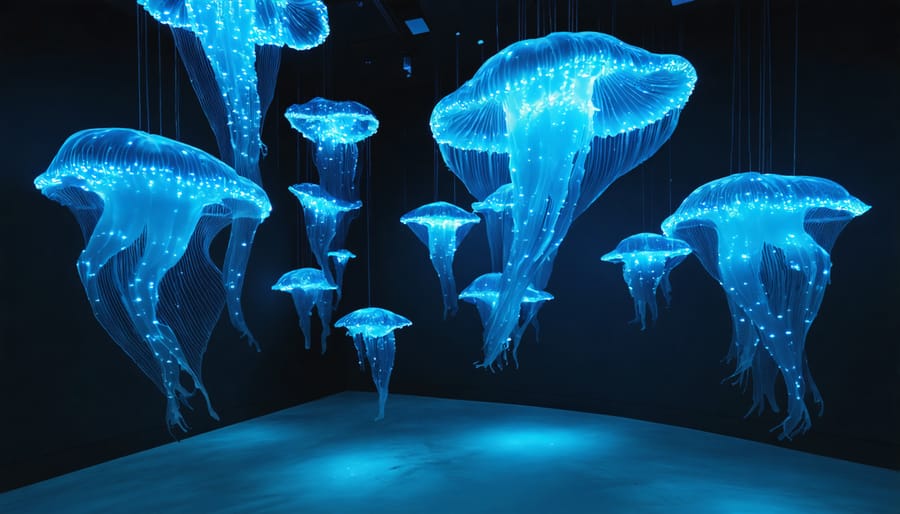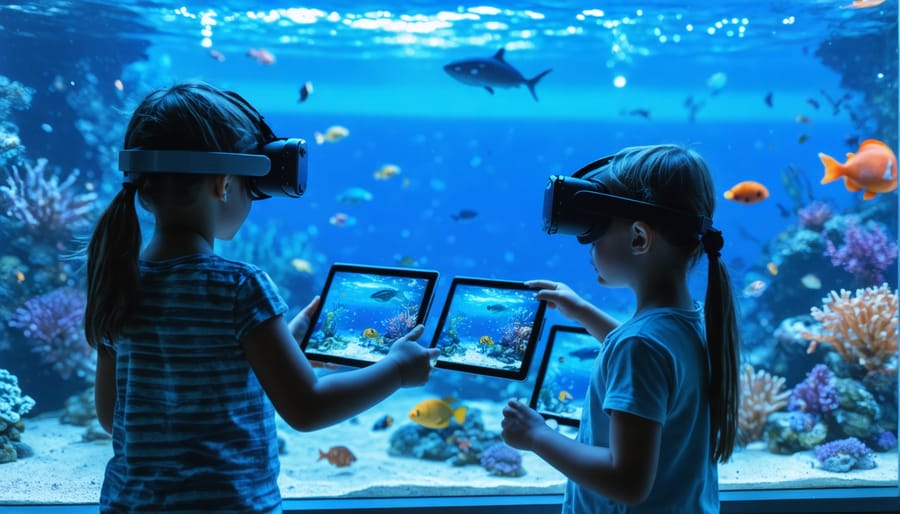
Transforming abstract marine concepts into tangible, three-dimensional experiences, 3D art installations bridge the gap between marine science into art in revolutionary ways. These immersive sculptures and multimedia displays capture the dynamic relationship between humanity and our oceans, creating powerful environmental narratives that resonate with viewers on both emotional and intellectual levels. From Jason deCaires Taylor’s underwater museums to Courtney Mattison’s intricate coral reef ceramics, these installations serve as critical tools for conservation awareness, drawing attention to marine biodiversity loss while inspiring action through their breathtaking presence. As climate change threatens our oceans, these artistic interventions offer unique opportunities to engage communities, challenge perspectives, and catalyze meaningful conversations about marine preservation. By combining cutting-edge technology with traditional sculptural techniques, contemporary artists are revolutionizing how we perceive and interact with marine ecosystems, making complex environmental issues accessible to diverse audiences worldwide.
The Power of Immersive Marine Art
Beyond Traditional Exhibits
Traditional aquarium exhibits, while informative, often create a barrier between viewers and marine life through thick glass panels and static displays. In contrast, interactive 3D art installations break down these barriers, allowing visitors to step into and become part of the marine environment. These immersive experiences utilize cutting-edge technology like motion sensors, responsive lighting, and spatial sound design to simulate underwater ecosystems.
Where conventional displays might show a preserved coral specimen behind glass, 3D installations can create virtual coral reefs that respond to visitor movements, demonstrating real-time effects of human interaction with marine environments. Digital projections and interactive elements enable visitors to witness the dynamic nature of ocean ecosystems, from the gentle sway of sea grass to the synchronized swimming patterns of fish schools.
The impact of these installations extends beyond mere visual appeal. While traditional exhibits rely on placards and recorded narratives, interactive installations engage multiple senses simultaneously, creating lasting emotional connections and deeper understanding of marine conservation challenges. This multisensory approach has proven particularly effective in educational settings, where students can literally walk through and interact with the marine phenomena they’re studying.

Technology Meets Marine Biology
Modern marine-themed installations blend cutting-edge technology with artistic vision to create immersive experiences that educate and inspire. Advanced projection mapping transforms flat surfaces into dynamic underwater scenes, while motion sensors enable interactive elements that respond to visitor movements, simulating marine life behavior.
3D printing technology has revolutionized the creation of precise replicas of coral structures and marine organisms, allowing artists to showcase intricate details that might be impossible to capture through traditional sculpting methods. These printed elements are often enhanced with LED lighting systems and programmable controllers that simulate natural bioluminescence and water movement patterns.
Augmented reality (AR) components add another dimension to installations, enabling visitors to use their smartphones to access additional information about species and ecosystems. Some installations incorporate hydrophones and underwater recording technology to bring authentic ocean soundscapes into the exhibition space.
Environmental sensors monitor temperature, humidity, and lighting conditions to maintain optimal viewing experiences while ensuring the longevity of the installation materials. This technological integration not only enhances the artistic impact but also serves as a powerful tool for marine education and conservation awareness.
Notable Marine-Inspired 3D Installations
Coral Reef Recreations
In recent years, coral reef installations have emerged as powerful tools where art meets ocean conservation, creating immersive experiences that educate visitors about marine ecosystems. Notable examples include Jason deCaires Taylor’s “Silent Evolution,” featuring over 400 life-sized human figures that serve as artificial reefs, promoting coral growth while raising awareness about ocean acidification.
The “Living Coral Biobank” in Australia showcases a dynamic installation combining LED technology with 3D-printed coral structures. This installation changes color and pattern based on real-time data from the Great Barrier Reef, providing visitors with a visceral understanding of coral bleaching events and recovery periods.
Another groundbreaking project, “Coral Cities,” uses biodegradable materials to create temporary reef structures that dissolve over time, leaving behind only naturally formed coral colonies. This installation demonstrates the delicate balance between human intervention and natural reef development.
In Singapore’s ArtScience Museum, “Virtual Reef Diver” allows visitors to interact with projection-mapped coral formations, creating an educational experience that highlights the importance of reef conservation. The installation responds to movement, simulating how human activity impacts marine ecosystems.
These installations not only serve as artistic expressions but also function as valuable educational tools, helping visitors understand complex marine ecology concepts through engaging, hands-on experiences. Many incorporate volunteer programs, allowing participants to contribute to real-world conservation efforts while learning about marine biodiversity.

Deep Sea Discoveries
The deep ocean, with its mysterious inhabitants and otherworldly landscapes, has inspired artists to create breathtaking 3D installations that bring these hidden realms to the surface. These immersive experiences transport viewers into the abyssal depths, showcasing bioluminescent creatures, deep-sea coral gardens, and the delicate ecosystems that thrive in complete darkness.
Notable installations include Jason deCaires Taylor’s “The Deep,” which features life-sized sculptures of marine species arranged in a darkened space, illuminated by carefully positioned LED lights that mimic natural bioluminescence. Visitors walk through corridors where giant squid tentacles seem to emerge from walls, and anglerfish appear to float in the darkness.
The “Abyssal Dreams” exhibition by Maya Lin incorporates real-time data from oceanographic research vessels, translating deep-sea temperature and pressure readings into dynamic light patterns that dance across suspended glass sculptures. This marriage of scientific data and artistic expression helps viewers understand the complex relationships between ocean depth, marine life, and environmental conditions.
Interactive elements often include touch-sensitive panels that trigger movements in sculptural elements, simulating the way deep-sea creatures respond to disturbances in their environment. Some installations utilize advanced projection mapping to create the illusion of swimming through hydrothermal vent fields or encountering rarely seen species like the vampire squid.
These installations serve as powerful educational tools, raising awareness about deep-sea conservation while creating memorable experiences that connect viewers to marine ecosystems they might never otherwise encounter.
Conservation Through Art
Educational Impact
Three-dimensional art installations have revolutionized marine science education by creating immersive learning environments that bridge the gap between theoretical knowledge and real-world understanding. These installations transform abstract concepts into tangible experiences, making complex marine ecosystems more accessible to students of all ages.
In classroom settings, scaled models of coral reefs and marine habitats help students visualize underwater environments they might never otherwise experience. Teachers report increased engagement and retention when using 3D installations as teaching aids, with students showing better comprehension of marine biodiversity concepts and ecological relationships.
Museums and aquariums have particularly benefited from these installations, using them to create interactive exhibits that simulate marine environments. Visitors can walk through life-sized kelp forests or examine detailed replicas of deep-sea creatures, fostering a deeper connection with marine life. This hands-on approach has proven especially effective in teaching about marine conservation challenges, such as plastic pollution and coral bleaching.
The educational impact extends beyond formal settings, with public installations in coastal communities serving as powerful tools for raising awareness about local marine ecosystems. These installations often incorporate local species and environmental data, helping residents understand and connect with their marine heritage while promoting conservation efforts.

Inspiring Environmental Action
Several 3D art installations have successfully catalyzed meaningful environmental action and helped shape ocean conservation efforts worldwide. The “Rising Tide” installation in Venice, Italy, depicting half-submerged horses made from marine debris, led to a 40% increase in local beach cleanup participation and inspired a citywide ban on single-use plastics.
In Australia, the “Reef Gallery” project, featuring life-sized coral formations created from recycled materials, sparked a community-driven initiative that resulted in the restoration of 2.5 acres of damaged reef habitat. The installation’s interactive elements allowed visitors to pledge support for conservation efforts, generating over $200,000 in donations for marine research.
The “Ocean Memory” exhibition in California transformed plastic waste into stunning marine life sculptures, leading to partnerships with local schools and establishing educational programs that have reached over 10,000 students. This initiative has inspired young environmentalists to launch their own conservation projects, including a successful campaign to protect local sea turtle nesting sites.
These installations demonstrate how art can bridge the gap between environmental awareness and concrete action, inspiring communities to become active participants in marine conservation efforts.
Creating Change Through Participation
Getting Involved
There are numerous ways to get involved with marine art installations and support ocean conservation through artistic expression. Many coastal museums and aquariums offer volunteer programs where you can assist with installation maintenance, guide visitors, or help create new exhibits. Organizations like the Marine Art Conservation Society regularly seek passionate individuals to participate in beach cleanups that often incorporate artistic elements.
Artists and conservationists can submit proposals for new installations through various marine art grant programs. These opportunities typically open annually and welcome both established and emerging artists. For educators and students, many institutions offer workshops and educational programs focused on combining marine science with artistic expression.
Digital platforms now enable virtual participation through online galleries, virtual reality experiences, and social media campaigns. Consider joining online communities dedicated to marine art or supporting crowdfunding initiatives for new installations. Local coastal communities often organize festivals and events where artists can showcase their work while raising awareness about marine conservation.
Future of Marine Art
The future of marine-themed art installations is evolving rapidly, with emerging technologies reshaping how we experience and interact with ocean-inspired art. Augmented reality (AR) installations are gaining prominence, allowing visitors to witness virtual marine ecosystems overlaid onto physical spaces. Artists are increasingly incorporating real-time data from ocean monitoring systems into their works, creating dynamic installations that reflect current marine conditions.
Sustainable materials are becoming central to marine-inspired design, with biodegradable elements and recycled ocean plastics featuring prominently in upcoming projects. Interactive elements are being enhanced through motion sensors and AI, enabling installations to respond to visitor movements and create immersive educational experiences.
Several major aquariums and marine research centers have announced collaborative projects combining art with citizen science initiatives, where visitors can contribute to real marine research while engaging with installations. These developments signal a shift toward more participatory, technology-driven experiences that strengthen the connection between art, science, and ocean conservation.
3D art installations have emerged as powerful tools in marine conservation, bridging the gap between scientific understanding and public engagement. These innovative artistic expressions not only captivate audiences but also create lasting impressions that inspire action and awareness about marine biodiversity challenges. Through the combination of artistic vision and environmental messaging, these installations have successfully reached diverse audiences, from young students to policy makers.
The impact of these installations extends beyond their physical presence, creating ripples of change in communities worldwide. They serve as catalysts for important conversations about ocean preservation, plastic pollution, and the urgent need to protect marine ecosystems. By transforming complex environmental data into visually striking experiences, these installations make marine conservation more accessible and emotionally resonant.
As we face increasing threats to our oceans, the role of 3D art installations in environmental education and advocacy becomes ever more crucial. You can contribute to this movement by supporting local marine conservation art projects, participating in beach cleanups that inspire these installations, or even organizing educational programs in your community. Together, we can harness the power of art to create meaningful change for our oceans’ future.
jessica
Ava Singh is an environmental writer and marine sustainability advocate with a deep commitment to protecting the world's oceans and coastal communities. With a background in environmental policy and a passion for storytelling, Ava brings complex topics to life through clear, engaging content that educates and empowers readers. At the Marine Biodiversity & Sustainability Learning Center, Ava focuses on sharing impactful stories about community engagement, policy innovations, and conservation strategies. Her writing bridges the gap between science and the public, encouraging people to take part in preserving marine biodiversity. When she’s not writing, Ava collaborates with local initiatives to promote eco-conscious living and sustainable development, ensuring her work makes a difference both on the page and in the real world.
